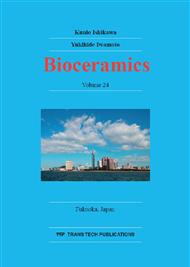[1]
J.P. Gleeson, N.A. Plunkett, F.J. O'Brien, Tissue engineering tools for modulation of the immune response, Bio Techniques. 51 (2011) 239-254.
Google Scholar
[2]
S. Iijima, Helical microtubules of graphitic carbon, Nature. 354 (1991) 56-58.
DOI: 10.1038/354056a0
Google Scholar
[3]
N. Sinha, JT. Yeow, Carbon nanotubes for biomedical applications, IEEE Trans Nanobioscience. 4 (2005) 180-195.
DOI: 10.1109/tnb.2005.850478
Google Scholar
[4]
M. Uo, K. Tamura, Y. Sato, A. Yokoyama, F. Watari, Y. Totsuka, K. Thoji, Cytotoxicity of metalencapsulating carbon nanocapsules, Small. 1 (2005) 816-819.
DOI: 10.1002/smll.200400143
Google Scholar
[5]
N. Aoki, A. Yokoyama, Y. Nodasaka, T. Akasaka, M. Uo, Y. Sato, K. Tohji, F. Watari, Cell culture on a carbon nanotube scaffold, J. Biomed. Nanotechnol. 1 (2005) 402-405.
DOI: 10.1166/jbn.2005.048
Google Scholar
[6]
N. Aoki, A. Yokoyama, Y. Nodasaka, T. Akasaka, M. Uo, Y. Sato, K. Tohji, F. Watari, Strinkgly extended morphology of cells grown on carbon nanotubes, Chem Lett. 35 (2006) 508-509.
DOI: 10.1246/cl.2006.508
Google Scholar
[7]
X. Li, H. Liu, X. Niu, B. Yu, Y. Fan, Q. Feng, FZ. Cui, F. Watari, The use of carbon nanotubes to induce osteogenic differentiation of human adipose-derived MSCs in vitro and ectopic bone formation invitro, Biomaterials. 33 (2012) 4818-4827.
DOI: 10.1016/j.biomaterials.2012.03.045
Google Scholar
[8]
N. Aoki, T. Akasaka, F. Watari, A. Yokoyama, Carbon nanotubes as scaffolds for cell culture and effect on cellularfunctions, Dent. Mat.J. 26 (2007) 178-185.
DOI: 10.4012/dmj.26.178
Google Scholar
[9]
TJ. Webster, MC. Waid, JL. Mckenzie, RL. Price, JU. Ejiofor, Nano-biotechnology: carbon nanofibers as improved neural and orthopedic implants, Nanotechnology. 15 (2005) 48-54.
DOI: 10.1088/0957-4484/15/1/009
Google Scholar
[10]
A. Abarratetegi, MC. Gutiérrez, C. Moreno-Vincent, MJ. Hortigüela, V. Ramos, JL. López-Lacomba, ML. Ferrer, F. del Monte, Multiwall carbon nanotubes scaffolds foe tissue engineering purpose, Biomaterials. 29 (2008) 94-102.
DOI: 10.1016/j.biomaterials.2007.09.021
Google Scholar
[11]
LE. Valenti, PA. Fiorito, CD. Garcia, CE. Giacomelli, The adsorption-desorption process of bovine serum albumin on carbon nanotubes, J. Colloid Interface Sci. 307 (2007) 349-356.
DOI: 10.1016/j.jcis.2006.11.046
Google Scholar
[12]
Y. Kuboki, T. Koshikawa, H. Takita, R. Fujisawa, MH. Lee, S. Abe, T. Akasaka, F. Watari, R. Sammons, Carbon nanotubes chromatography separated albumin from other serum proteins: a method for direct analysis of their interactions, Dent. Mat.J. 29 (2010).
DOI: 10.4012/dmj.2009-097
Google Scholar
[13]
Y. Sato, A. Yokoyama, K. Shibata, Y. Akimoto, S. Ogino, Y. Nodasaka, T. Kohgo, K. Tamura , T. Akasaka, M. Uo, K. Motomiya, B. Jeyadevan, M. Ishiguro, R. Hatakeyama, F. Watari, K. Tohji , Influence of length on cytotoxity of multi-walled carbon nanotubes against human acute monocytic leukemia cell line THP-1 in vitro and subcutaneous tissue of rats in vivo, Mol Biosyst. 1 (2005).
DOI: 10.1039/b502429c
Google Scholar
[14]
H. Peng, LB. Alemany, JL. Margrave, VN. Khabashesku, Sidewall carboxylic acid functionalization of single-walled carbon nanotubes, J. Am. Chem. Soc. 125 (2003) 15174-15182.
DOI: 10.1021/ja037746s
Google Scholar
[15]
Z. Du, YL. Yu, XW. Chen, JH. Wang, The isolation of basic proteins by solid-phase extraction with multiwalled carbon nanotubes. Chem Eur J 2007; 13: 9679-9.
DOI: 10.1002/chem.200700784
Google Scholar


